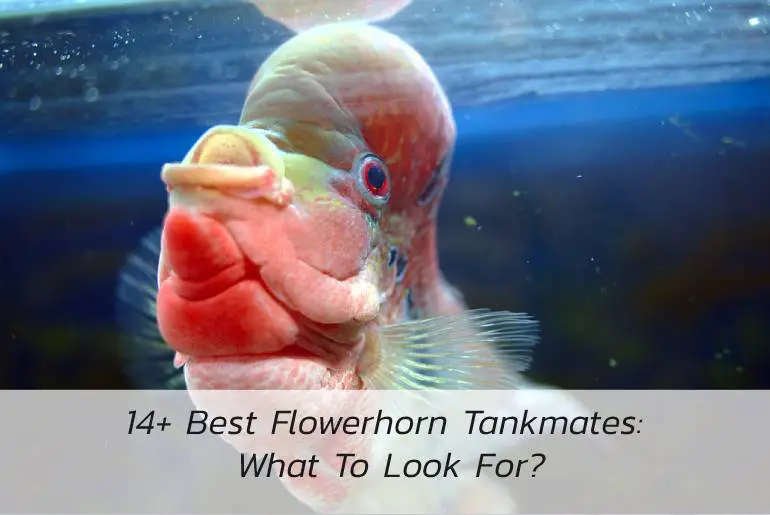When it comes to choosing the best tankmates for your Flowerhorn, there are a few things you need to take into account. Some fish will be too aggressive and may cause problems in the tank, while others may not provide enough competition or stimulation for your Flowerhorn. In this blog post, we will discuss the different types of fish that make good tankmates for your Flowerhorn and also talk about how to deal with any aggression that may occur.
Some of the best tankmates for your flowerhorn are:
- Silver Arowana
- Wolf Cichlids
- Pacu Fish
- Midas Cichlids
- Jaguar Cichlids
- Blood-Red Parrot Cichlid
- Common Pleco
- Bichir Dragonfish
We will learn more about these fish in the next section.
What To Look For In Tankmates For Flowerhorn?
When you are looking for potential tankmates for your Flowerhorn, there are a few things you need to take into account.
Size
The first thing is the size of the fish. You want to make sure that the fish is not too small, as your Flowerhorn may see it as food and try to eat it.
Aggression
The second thing is the temperament of the fish. You want to avoid any fish that are too aggressive, as they may start to pick on your Flowerhorn or cause other problems in the tank.
Level of Activity
When choosing tankmates for your flowerhorn, you’ll want to consider the third thing: the level of activity of the fish.
You want to make sure that the fish are active enough to provide stimulation for your flowerhorn, but not so active that they will constantly be running into your flowerhorn and causing problems.
The best way to determine the level of activity of a fish is to observe it in its natural habitat. If you see the fish swimming around rapidly and constantly changing directions, it’s likely to be too active for your flowerhorn.
On the other hand, if the fish is mostly resting on the bottom or floating lazily near the surface, it’s probably a good choice.
Similar Water Parameters
When choosing fish to be tankmates with your flowerhorn, it’s important to make sure that they can tolerate the same water parameters. This includes things like pH, temperature, and hardness.
You don’t want to end up in a situation where one fish is uncomfortable because the water parameters are too different.
Flowerhorns are also known to be aggressive eaters, so you’ll want to make sure that your tankmates are big enough to not be eaten. Choosing the right tankmates for your flowerhorn is an important part of keeping them healthy and happy.
Now that we know what to look for in potential tankmates, let’s take a closer look at some of the best fish for your Flowerhorn.
What Type Of Tankmates Should You Avoid For Flowerhorn?
Even though Flowerhorns are usually peaceful fish, there are still some tankmates that you should avoid.
The first type of fish to avoid are those that are too small. As we mentioned before, Flowerhorns are known to be aggressive eaters and may see smaller fish as food. The second type of fish to avoid is those that are too aggressive.
As we mentioned, Flowerhorns are usually peaceful fish but can become aggressive if they feel threatened. If you have a fish that is constantly starting fights or nipping at other fish, it’s best to avoid putting them in the same tank as your Flowerhorn. The last type of fish to avoid are those that are not active enough.
As we mentioned, Flowerhorns need stimulation and may become bored if they are in a tank with fish that are not active enough. If you have a fish that is mostly inactive, it’s best to avoid putting them in the same tank as your Flowerhorn.
Best Tankmates For Flowerhorn
Now that we know what to look for in potential tankmates, let’s take a closer look at some of the best fish for your Flowerhorn.
Silver Arowana
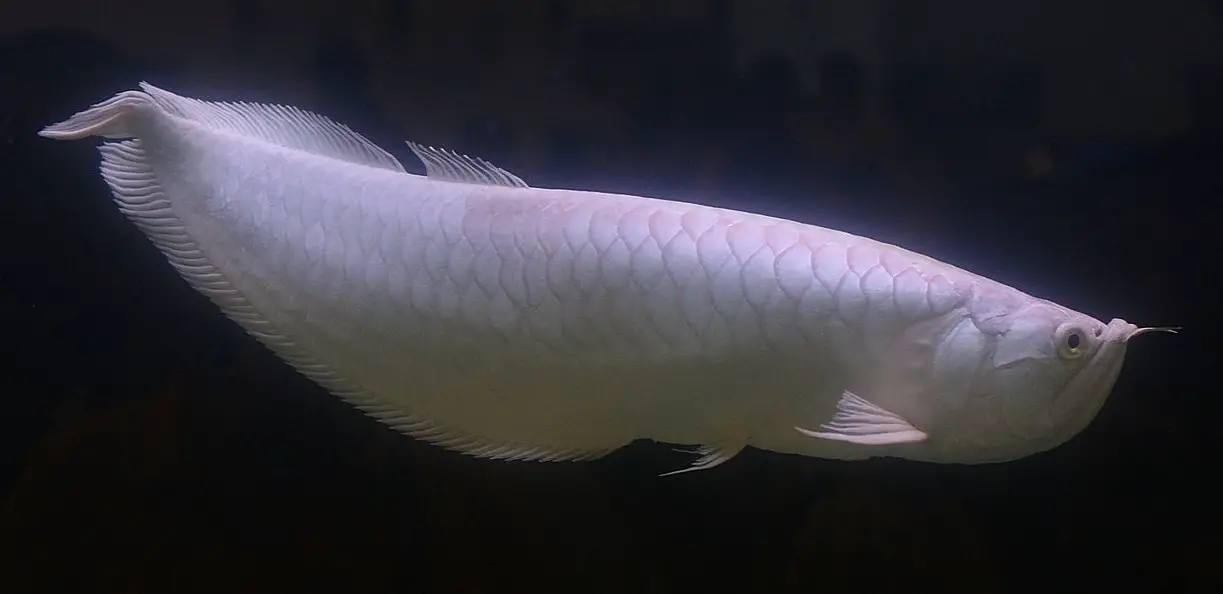
Silver Arowanas are interesting fish that are well-known for their hunting abilities. They have an unusual jawline and flat mouth that points upwards, and their bodies are covered in scales that look like shining silver pearls.
In their juvenile period, these scales usually have a blue shade to them. Silver Arowanas can be scared by quick movements inside or outside the tank, and they mostly swim near the surface of the water.
If they are not given enough space to swim, they will jump out of the tank. Silver Arowanas are also known to be good jumpers – they can leap out of the water and onto land! – so it is important to keep their tank covered.
If you’re looking for an interesting and active fish, the Silver Arowana is a good choice.
Wolf Cichlids
Wolf Cichlids are a type of fish that is native to Central America. They are known for their beautiful colors and patterns, as well as their aggressive behavior.
Wolf Cichlids can grow to be quite large, so it’s important to make sure that you have a tank that is big enough to accommodate them.
They are also known to be very messy eaters, so you’ll need to make sure that you have a good filtration system in place.
If you’re looking for a fish that is both beautiful and active, the Wolf Cichlid is a good choice.
Pacu Fish

Pacu fish are native to the Amazon basin, but they have been introduced to many other tropical areas around the world.
Moreover, Pacu is omnivorous and their diet consists of both plants and animals. This fish has strong jaws and sharp teeth that they use to tear their food. Pacu can grow to be up to four feet long and can weigh up to sixty pounds.
They are popular aquarium fish, but they have also been known to escape from captivity and establish themselves in new areas.
In some parts of the world, Pacu is a nuisance species because they compete with native fish for food. Pacu has also been known to attack swimmers, leading some people to call them “human eaters.” Despite their reputation, Pacu is typically a peaceful fish and makes good tank mates for other species.
Midas Cichlids

Midas cichlids are a type of fish that is native to Central America. They get their name from the yellow/gold color of their bodies.
Midas cichlids can grow to be quite large, so it’s important to make sure that you have a tank that is big enough to accommodate them.
They are also known to be very messy eaters, so you’ll need to make sure that you have a good filtration system in place.
If you’re looking for a fish that is both beautiful and active, the Midas cichlid is a good choice.
Jaguar Cichlids

Jaguar cichlids are a type of fish that is native to Central America. They get their name from the spots on their bodies, which resemble the spots on a jaguar.
Jaguar cichlids can grow to be quite large, so it’s important to make sure that you have a tank that is big enough to accommodate them.
They are also known to be very messy eaters, so you’ll need to make sure that you have a good filtration system in place.
The Jaguar Cichlid is a beautiful freshwater fish that is native to Central and South America. It gets its name from its spots, which resemble the pattern on a jaguar’s coat. The Jaguar Cichlid is a large fish and can grow to be about two feet long. It is a popular choice for aquariums because of its vibrant colors and interesting patterns.
Jaguar Cichlids are not the easiest fish to care for, however, and need a spacious tank with plenty of hiding places. They are also known to be quite aggressive, so it is important to do your research before adding one to your home aquarium. But if you are up for the challenge, a Jaguar Cichlid can make a beautiful and intriguing addition to your fish family.
Blood-Red Parrot Cichlid
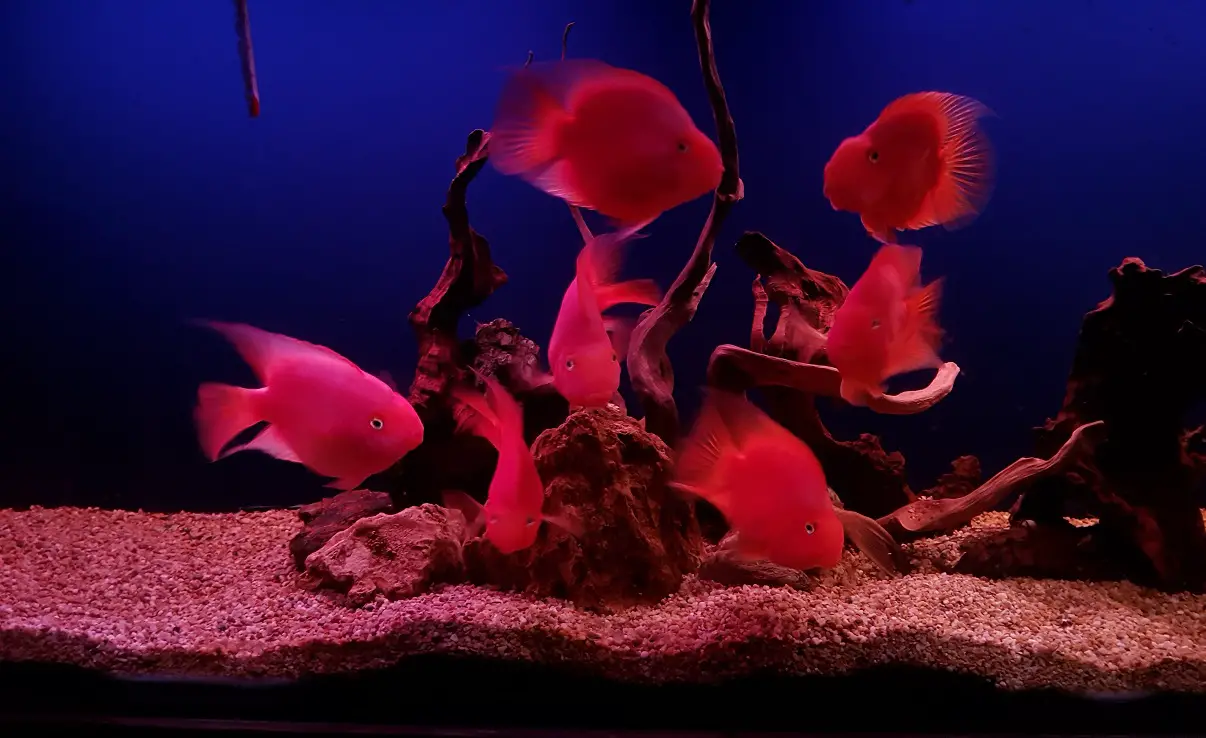
The Blood-Red Parrot Cichlid is a beautiful fish that is popular among aquarium enthusiasts. Native to Central America, these fish are easily recognizable by their vibrant red coloration.
Blood-Red Parrot Cichlids are relatively peaceful fish, and they make a great addition to any community tank. These fish are omnivores, and they will consume both plant and animal matter. In the wild, Blood-Red Parrot Cichlids inhabit rivers and streams with sandy bottoms.
Aquariums should mimic this natural habitat as closely as possible. Blood-Red Parrot Cichlids are relatively easy to care for, and they are a great choice for beginners. With proper care, these fish can live for 10 years or more.
Common Pleco
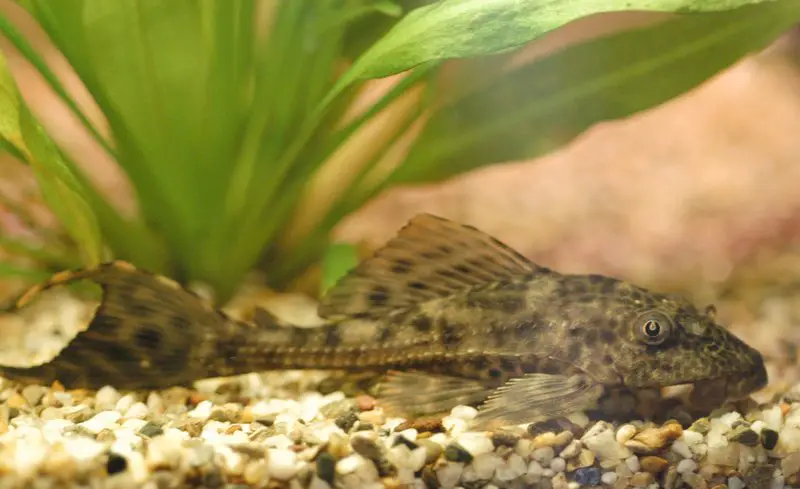
These fish are easily recognizable by their large size and sucker-like mouths.
Common Plecos can grow to be up to two feet long, and they require a tank that is at least 50 gallons. These fish are nocturnal, and they will spend most of the day hiding in caves or other dark places.
Common Plecos are omnivores, and they will consume both plant and animal matter. In the wild, these fish inhabit rivers and streams with rocky bottoms. Aquariums should mimic this natural habitat as closely as possible.
Common Plecos are relatively easy to care for, and they are a great choice for beginners. With proper care, these fish can live for 15 years or more.
Bichir Dragonfish

The Bichir Dragonfish is a type of freshwater fish that is native to Africa. These fish are easily recognizable by their long bodies and strange-looking fins.
Bichir Dragonfish is a good choice for Flowerhorn tankmates because they are peaceful and can help to keep the tank clean. These fish are also relatively hardy and can tolerate a wide range of water conditions.
One thing to keep in mind, however, is that Bichir Dragonfish can grow to be quite large. As such, you will need to provide them with a tank that is at least 75 gallons in size.
Clown Loaches

Clown Loaches are another good choice for Flowerhorn tankmates. These fish are native to Southeast Asia and are easily recognizable by their orange bodies and black stripes.
Clown Loaches are peaceful fish that do well in groups. They are also good at keeping the tank clean and can help to control algae growth.
One thing to keep in mind, however, is that Clown Loaches can grow to be quite large. As such, you will need to provide them with a tank that is at least 75 gallons in size.
Oscar Fish

The Oscar fish is a popular freshwater aquarium fish that is native to South America. They are known for their bright colors, intelligence, and playful personality. Oscars can grow to be quite large, so it is important to provide them with a spacious tank.
They are also active swimmers and need plenty of open space to move around. In the wild, Oscars typically eat other fish, so it is important to provide them with a diet that mimics their natural diet.
Pellets or flakes designed for cichlids are a good option. Oscars are also known for being very social creatures and do best when kept in pairs or small groups. With proper care, Oscars can make rewarding and enjoyable pets.
Green Terror Cichlid
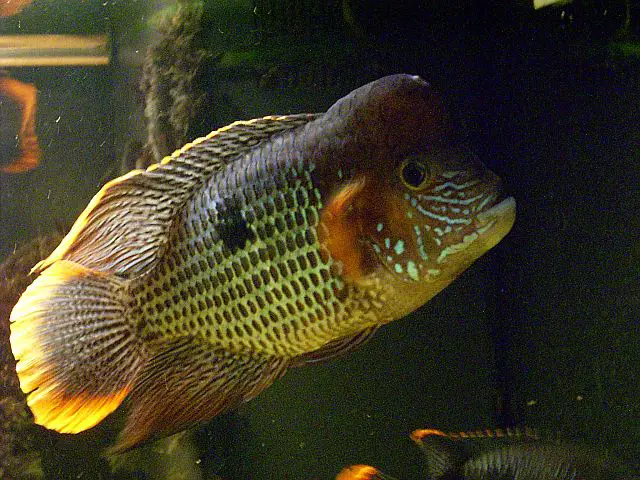
The Green Terror Cichlid is a freshwater fish that is native to the Amazon Basin in South America. It is a popular aquarium fish and is known for its vibrant coloration and aggressive behavior. The Green Terror Cichlid can grow to be about 12 inches long and has a lifespan of about 15 years.
The Green Terror Cichlid is an omnivore and will eat both plants and animals. In the wild, their diet consists of small fish, insects, crustaceans, and worms. In the aquarium, they should be fed a variety of foods such as pellets, flakes, live food, frozen food, and vegetables.
Green Terror Cichlids are very territorial and aggressive towards other fish. They should only be kept with fish that are of similar size and temperament. It is also important to provide them with plenty of hiding places and plenty of open space to swim. With proper care, the Green Terror Cichlid can make a rewarding and enjoyable pet.
Texas Cichlids

Texas cichlids are a popular choice for freshwater aquariums. These beautiful fish are native to the rivers and streams of Texas and Mexico, and they come in a variety of colors and patterns. Texas cichlids are relatively easy to care for, and they make great additions to any community aquarium.
Texas cichlids are typically 12 inches in length, and they have a lifespan of 10-13 years. These fish are omnivorous, so they require a diet that includes both plant and animal matter. In the wild, Texas cichlids eat insect larvae, crustaceans, and small mollusks. In captivity, they can be fed a diet of pellets, flakes, or live foods.
When keeping Texas cichlids with other fish species, it is important to choose tank mates that are similar in size and temperament. Some good choices for Texas cichlid tank mates include other cichlids, catfish, Tetras, and Rasboras.
Acara Cichlids

Flowerhorns are beautiful, unique fish that make a great addition to any aquarium. They are relatively easy to care for and can thrive in a wide range of environments.
When choosing tankmates for your Flowerhorn, it’s important to choose fish that are compatible in size and temperament. Acara cichlids make excellent tankmates for Flowerhorns.
They are peaceful fish that enjoy similar water conditions. In addition, they are active cleaners and will help keep the tank clean. Acara cichlids are also relatively easy to care for, making them a good choice for beginner aquarists.
If you’re looking for a beautiful, low-maintenance fish to add to your aquarium, consider Acara cichlids.
Three Spot Cichlid
The Three Spot Cichlid is a beautiful fish that can be found in the slow-flowing stretches of Central American rivers. Its scales are a mixture of green and yellow with black spots on the sides and one red spot next to the gills.
These cichlids are peaceful fish that swim near the bottom of the tank, hiding among roots, weeds, or pretty much any decoration. If there are smaller fish in the tank, then the Three Spot Cichlid is definitely going to eat them.
An interesting fact about the Three Spot Cichlid is that it was one of the required fish breeds for creating the Flowerhorn. If you’re thinking about adding a Three Spot Cichlid to your fish tank, be sure to do your research to provide them with the best possible habitat.
Giant Gourami

The Giant Gourami is a peaceful fish that is native to the slow-moving waters of Southeast Asia. It has a long, oval-shaped body and can grow to be over two feet in length.
Giant gouramis are slow eaters and prefer to graze on algae throughout the day. They are also known to be good jumpers, so it’s important to have a tight-fitting lid on your aquarium.
If you’re looking for a low-maintenance fish that will help keep your tank clean, the Giant Gourami is a good choice.
How to Deal with Flowerhorn’s Aggressive Behavior?
Flowerhorns are known to be aggressive fish, especially when they are kept with smaller tankmates. If you’re thinking about adding a Flowerhorn to your aquarium, it’s important to do your research and choose compatible tankmates.
Tank Space
First, it is important to provide each fish with plenty of space. Flowerhorns should have at least 20 gallons of space per fish, and they should not be kept with smaller fish or invertebrates.
It is also important to provide hiding places for your fish. Plants, rocks, and caves will all help to give your fish a sense of security and reduce their stress levels.
SeaClear Acrylic Combo Aquarium is a good tank with a spacious overview for your flowerhorn.
Feed Quality Diet
Be sure to feed your flowerhorn a high-quality diet. A healthy diet will help to reduce aggression and ensure that your fish stay in good condition.
By following these simple tips, you can enjoy the beauty of flowerhorns without having to deal with their sometimes troublesome behavior.
A quality diet for flowerhorn can be the following:
- Hikari Flowerhorn Fish Food
- OKIKO flowerhorn Cichlid Fish
- Fluval A6581 Bug Bites Cichlid Pellets
- Amzey Dries Shrimp Fish Foods
- Appetizing Shrimp Mealworms
- Tetra Jumbokrill Jumbo Shrimp
- Ocean Pellets Humpy Xo Flowerhorn Food
Hiding Spaces
Flowerhorns are a type of cichlid that are known for their aggressive behavior. If you have a Flowerhorn, you may be looking for ways to deal with their aggression. One way to do this is to provide hiding places for their potential prey.
This can be done by adding plants, rocks, or other decorations to the tank. By providing hiding places, you can give the smaller fish a chance to escape the Flowerhorn’s aggression.
Decrease Stress
In addition, you can also try to reduce the amount of stress in the tank.
This can be done by providing plenty of space, keeping the water clean, and maintaining a stable temperature. By reducing the amount of stress in the tank, you can help to reduce the Flowerhorn’s aggression.
Compatible Tankmates
Another way to deal with a Flowerhorn’s aggression is to choose tankmates that are compatible in size and temperament. peaceful fish that can hold their own against a Flowerhorn’s aggression.
Some compatible tankmates include Silver Arowana, Wolf Cichlids, Pacu Fish, Midas Cichlids, Jaguar Cichlids, and Blood-Red Parrot Cichlid.
Avoid Keeping Small Fish
Flowerhorns are a popular type of freshwater fish, known for their vibrant colors and aggressive nature. If you’re thinking of adding a Flowerhorn to your aquarium, there are a few things you should keep in mind.
First, Flowerhorns can be quite aggressive, so it’s best to avoid keeping small fish with them. Instead, opt for larger fish that can hold their own against the Flowerhorn’s aggression. In addition, Flowerhorns are voracious eaters and will consume anything they can fit into their mouths.
As a result, you’ll need to provide them with plenty of food. Otherwise, they may start to nibble on plants or other decorations in the aquarium. With proper care, Flowerhorns can make lively and interesting additions to any freshwater aquarium.
Conclusion
Flowerhorns are unique and beautiful fish that make great pets. When choosing tankmates for your Flowerhorn, it is important to choose fish that are peaceful, can help keep the tank clean, and are the same size or larger than your Flowerhorn.
With proper care, your Flowerhorn will thrive and bring you years of enjoyment. Thanks for reading! I hope this article was helpful! Please feel free to leave a comment below if you have any questions.

